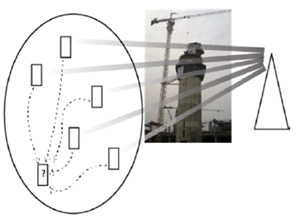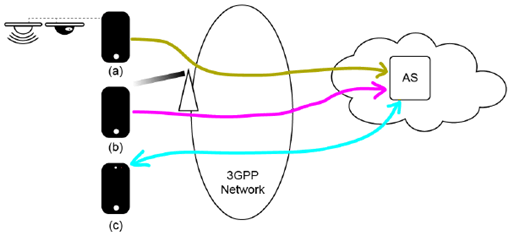Content for TR 22.837 Word version: 19.3.0
0…
4
5…
5.2…
5.3…
5.4…
5.5…
5.6…
5.7…
5.8…
5.9…
5.10…
5.11…
5.12…
5.13…
5.14…
5.15…
5.16…
5.17…
5.18…
5.19…
5.20…
5.21…
5.22…
5.23…
5.24…
5.25…
5.26…
5.27…
5.28…
5.29…
5.30…
5.31…
5.32…
6…
7…
5.19 Use case on Sensor Groups
5.19.1 Description
5.19.2 Pre-conditions
5.19.3 Service Flows
5.19.4 Post-conditions
5.19.5 Existing feature partly or fully covering use case functionality
5.19.6 Potential New Requirements needed to support the use case
...
...
5.19 Use case on Sensor Groups p. 56
5.19.1 Description p. 56
Sensing has been considered in this technical report in terms of interaction between a UE and a base station. This information however is only partial, as it extends along a limited UE-base station axis. This information however can be considered a component of a scene that, when gathered with other available sensor data, can be synthesized into more comprehensive information.
Where the sensor is video, LiDAR, sonar, etc., (that is, it operates in some other way than 3GPP defined radio access technology,) it is still valuable to gather simultaneous sensor data and combine it. Only this way can sensor data capturing a scene (such as the front and back and sides of an object of interest, etc.) be obtained.
In the Localized Mobile Metaverse Services use case 5.1 in [11], includes the following text "His mobile device begins to collect information about his surroundings. The collected information can include information that is obtained by interacting with nearby devices (e.g. sensors and other mobile devices)."
This use case explores the implications of this function. Specifically, how can a UE identify sensors that are present that can provide information sought by the UE?
In this particular use case, on a construction site, a crane is lifting a large object near a tower. Construction worker safety, efficient pursuit of tasks and other situational awareness to prevent disasters are important tasks. Instead of merely relying on the crane operator, this use case allows the 5G system to model and track the tower, crane and payload as it is in motion.

In Figure 5.19.1-1, the UE is on a construction site. It seeks to identify sensors available at that site to provide sensing data potentially relevant to obtaining information for the user. These sensors - in the UE's proximity and available to provide sensor data (that is, this service is authorized,) comprise a sensor group.
Correspondence between Sensor Groups and other groups defined in stage 2 are neither implied by this use case nor excluded. There is no correspondence between Sensor Groups and other groups defined in stage 1.
The use case assumes that sensors that can form a sensor group are either UEs or communicate by means of a UE (as a kind of 'split terminal equipment (TE)' UE.)
It is essential to capture a 'synchronous' group of sensors and their movements in 3 dimensions in order to optimally combine the sensor data for the purpose of localization computations. This is particularly important when the viewer is near a large object or any non-static object must be modeled on all sides. This is an active area of research, for example in 6DoF Tracking and sensing. [44] The techniques described in this paper concern how to determine the 3D position and orientation of drones with synchronization, but it is clear that this is a fundamental requirement of a group of sensors providing input on a single physical object in (absolute or relative) motion.
The synchronous group of sensors form a logical set of devices whose data acquisition is critical for a particular task. The handling of this group is unique to this problem domain because (i) the need to synchronize the uplink transmissions of sensor measurement data of members of the group, so they can be combined in a timely way to produce a meaningful sensor measurement result of an object in motion, (ii) the dynamic nature of this group as the set of sensors that are appropriate to use can change often: the set of sensors prepared to obtain sensor measurement data of moving objects will change over time.
In this use case, a user's UE identifies a sensor group, through interaction with an AS. Part of identification of the sensors in the group is obtaining sufficient information that the user can become authorized to obtain sensor data, and the relevant service access information is obtained. The goal of the use case is to enable the acquisition of sensor data in a UE's proximity. The communication of the sensing data itself is out of scope of this use case.
Discovery of the kind described here can potentially be accomplished by different radio technologies, e.g. NR ProSe, UWB, IEEE 802.11, etc.
5.19.2 Pre-conditions p. 57
Benoît inspects various construction sites. He has a UE equipped with a set of surveillance and appraisal applications.
On construction sites he visits, there are sensors deployed. Some are UEs, e.g. using NR-based sensing. Other sensors include video cameras, LiDAR equipment and passive infrared sensors. These are not, generally, installed directly in the terminal equipment, but rather use the terminal equipment to communicate, as shown in Figure 5.19.2-1.

In the scenario above, (a) is a UE that serves various sensors that are themselves not UEs. The means by which these sensors communicate with the UE is out of scope of this use case. They could be e.g. connected by means of a physical cable. (b) is a UE that is capable of 3GPP defined sensing. (c) is a UE that can operate the UE camera for sensing purposes.
As the RF measurement data contains sensitive information (e.g. location of sensing transmitter/receiver, information about objects) from the 3GPP system it is processed in the 5G network to produce sensing results. 3GPP sensing data is not shared outside of 5G network. Application enabler layer combines these results with other data like non-3GPP sensing data to produce combined sensing results.
In this example (a) and (b) are authorized and ready to send mobile originated sensing data to an AS.
The non-3GPP sensing data from UEs and sensing results from 3GPP network acquired by the AS can be combined in software in a manner that is out of scope of the 5G standard. In this use case, the combination is performed by the AS.
Benoît's UE, (c), is authorized to access the media (the sensing result output of the AS produced by taking account of the non-3GPP sensing data from (a) and (b), sensing results from 3GPP network) provided by the AS.
Benoît, using UE (c), monitors the construction site for safety and efficiency.
5.19.3 Service Flows p. 58
Benoît's UE (c) uses functionality provided by the 5G system to seek to determine the existence of UEs (a) and (b), referring to Figure 5.19.2-1.
UE (c) has knowledge of the AS that accumulates sensor information that could be of interest.
UE (c) requests of the AS that accumulates sensor information for a sensor group: what sensors are in the proximity?
UE (c) is able to become authorized to receive information concerning the sensor group.
The Application Server (AS) requests the 5G system obtain a sensing group.
The 5G system will identify the set of sensing group members that provide the AS with sensor information that are in the proximity of UE(c). The 5G system will strive to synchronously locate 4 or more devices, to be localized within 10cm of accuracy, with accuracy of measurement within 5 ms of synchronization.
The AS provides UE (c) with sufficient information to identify the sensing group that are ready to provide non-3GPP sensing data and sensing results as well as how to get sensing data from the sensing group from the AS.
UE (c) requests to obtain combined sensing results from the AS/sensing group. The sensors must be within proximity and their locations are known with great accuracy (within 10cm in 3D), with accuracy of measurement within 5 ms of synchronization.
UE (c) is authorized to obtain combined sensing results from the AS/sensing group.
UE (a), UE (b) provide non-3GPP sensing data and the network provides sensing results. These are received by the AS and combined. This combined sensing result is provided to UE (c) by the AS.
UE (b) is mobile and its position varies. UE (c) must identify its position with sufficient accuracy to interpret the sensing result meaningfully. Since UE (b) is mobile, its position and movements must be tracked to provide accuracy up to 10 cm, with accuracy of measurement within 5 ms of synchronization.
UE (b) leaves the proximity of UE (c). UE (c) identifies that UE (b) has left the sensing group.
Later, UE (b) returns to proximity of UE (c). UE (c) identifies that UE (b) has joined the sensing group, including its position within 10 cm, with accuracy of measurement within 5 ms of synchronization.
The crane operations are monitored by sensors (a) and (b), providing different perspectives by means of non-3GPP sensing data from non-3GPP sensors and sensing results from the 3GPP network to the AS.
5.19.4 Post-conditions p. 58
Benoît, making use of UE (c), is able to ascertain with very high accuracy the location and movement of the entire group of UEs that can form a sensor group. The ability of UE (c) to identify the position and membership of the group continues over time, so that the current membership of the group is known, and that membership can change.
The AS is able to combine the non-3GPP sensing data acquired by non-3GPP sensors and sensing results acquired by 3GPP network from different perspectives and produce a useful 3D representation of the site to the site supervisor, who receives the combined sensing result by means of media delivered from the AS to the Benoît's UE (c).
5.19.5 Existing feature partly or fully covering use case functionality p. 59
There are requirements specified in 22.261, 6.37.2 to support ranging services that are relevant to this use case. These were developed in the FS_Ranging study. [43]
- The 5G system shall be able to support for a UE to discover other UEs supporting ranging.
- The 5G system shall be able to start ranging and stop ranging according to the application layer's demand.
- The 5G system shall be able to provide mechanisms for a MNO, or authorized third-party, to provision and manage ranging operation and configurations.
- The 5G system shall be able to support ranging enabled UEs to determine the ranging capabilities (e.g. capabilities to perform distance and/or angle measurement) of other ranging enabled UEs.
- The 5G system shall be able to allow a ranging enable UE to determine if another ranging enabled UE is stationary or mobile, before and/or during ranging.
- The 5G system shall allow ranging service between 2 UEs triggered by and exposed to the application server.
- Sensing data is not acquired 'between UEs' but by means of different sensing technologies.
- It is not sufficient to discover other UEs that support sensing: these must be in the discovering UE's proximity and the discovered UE's precise location must be ascertained.
- In this use case, a 'sensing group' is formed, where in Ranging, all range information was acquired through interactions directly (or indirectly if relayed) between UEs.
5.19.6 Potential New Requirements needed to support the use case p. 59
[PR 5.19.6-1]
Based on third-party request, the 5G system shall be able to discover a suitable sensing group where sensing transmitters and receivers are within 100m range to be localized within 10cm of accuracy, with accuracy of sensing measurement process within 5 ms of synchronization.
[PR 5.19.6-2]
Based on third-party request, the 5G system shall be able to discover a sensing group in the proximity of the UE that is requesting the service from the AS.